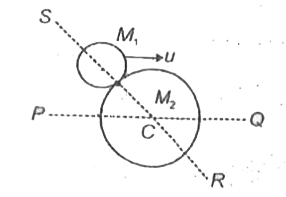Two objects slide over a frictionless horizontal surface The first object, mass m1=5 kg, is propelled with a speed u=4.5m/s towards the second object, mass m2=2.5 kg while is intially at rest. After the collision, both objects have velocities which are directed at θ=30∘ on either side of the original line of motion of the first object. What are the final speed of the two object? Is the collision elastic or inelastic?
To solve the problem step by step, we will analyze the collision of the two objects using the principles of conservation of momentum and kinetic energy.
Step 1: Understand the Problem
We have two objects:
- Object 1 (mass m1=5kg) moving with an initial speed u=4.5m/s.
- Object 2 (mass m2=2.5kg) is initially at rest.
After the collision, both objects move at an angle θ=30∘ to the original line of motion of object 1.
Step 2: Apply Conservation of Momentum
The total momentum before the collision must equal the total momentum after the collision. We will analyze the momentum in both the x-direction and y-direction.
X-direction:
Before the collision:
- Momentum of m1 = m1u
- Momentum of m2 = 0 (since it is at rest)
After the collision:
- Momentum of m1 = m1v1cos(30∘)
- Momentum of m2 = m2v2cos(30∘)
Setting the initial momentum equal to the final momentum in the x-direction:
m1u=m1v1cos(30∘)+m2v2cos(30∘)
Y-direction:
Before the collision:
- Momentum of m1 in the y-direction = 0
After the collision:
- Momentum of m1 = m1v1sin(30∘) (upward)
- Momentum of m2 = m2v2sin(30∘) (downward)
Setting the initial momentum equal to the final momentum in the y-direction:
0=m2v2sin(30∘)−m1v1sin(30∘)
Step 3: Solve the Equations
From the y-direction equation:
m2v2sin(30∘)=m1v1sin(30∘)
This simplifies to:
m2v2=m1v1
Substituting m1=5kg and m2=2.5kg:
2.5v2=5v1⇒v2=2v1
Now substituting v2 in the x-direction equation:
m1u=m1v1cos(30∘)+m2(2v1)cos(30∘)
5⋅4.5=5v1cos(30∘)+2.5(2v1)cos(30∘)
22.5=5v1cos(30∘)+5v1cos(30∘)
22.5=10v1cos(30∘)
v1=22.510cos(30∘)=22.510⋅√32=22.5⋅210√3=4.5√3m/s
Now, substituting v1 back to find v2:
v2=2v1=2⋅4.5√3=9√3=3√3m/s
Step 4: Check if the Collision is Elastic
To determine if the collision is elastic, we check if kinetic energy is conserved.
Initial Kinetic Energy:
KEinitial=12m1u2=12⋅5⋅(4.5)2
Final Kinetic Energy:
KEfinal=12m1v21+12m2v22
Substituting the values of v1 and v2:
KEfinal=12⋅5⋅(4.5√3)2+12⋅2.5⋅(3√3)2
Calculating both energies:
- If KEinitial=KEfinal, then the collision is elastic.
Final Answers:
- Final speed of object 1 (v1) = 4.5√3m/s
- Final speed of object 2 (v2) = 3√3m/s
- The collision is elastic.
We have two objects:
- Object 1 (mass m1=5kg) moving with an initial speed u=4.5m/s.
- Object 2 (mass m2=2.5kg) is initially at rest.
The total momentum before the collision must equal the total momentum after the collision. We will analyze the momentum in both the x-direction and y-direction.
Before the collision:
- Momentum of m1 = m1u
- Momentum of m2 = 0 (since it is at rest)
- Momentum of m1 = m1v1cos(30∘)
- Momentum of m2 = m2v2cos(30∘)
m1u=m1v1cos(30∘)+m2v2cos(30∘)
Before the collision:
- Momentum of m1 in the y-direction = 0
- Momentum of m1 = m1v1sin(30∘) (upward)
- Momentum of m2 = m2v2sin(30∘) (downward)
0=m2v2sin(30∘)−m1v1sin(30∘)
From the y-direction equation:
m2v2sin(30∘)=m1v1sin(30∘)
This simplifies to:
m2v2=m1v1
2.5v2=5v1⇒v2=2v1
m1u=m1v1cos(30∘)+m2(2v1)cos(30∘)
5⋅4.5=5v1cos(30∘)+2.5(2v1)cos(30∘)
22.5=5v1cos(30∘)+5v1cos(30∘)
22.5=10v1cos(30∘)
v1=22.510cos(30∘)=22.510⋅√32=22.5⋅210√3=4.5√3m/s
v2=2v1=2⋅4.5√3=9√3=3√3m/s
To determine if the collision is elastic, we check if kinetic energy is conserved.
KEinitial=12m1u2=12⋅5⋅(4.5)2
KEfinal=12m1v21+12m2v22
Substituting the values of v1 and v2:
KEfinal=12⋅5⋅(4.5√3)2+12⋅2.5⋅(3√3)2
- If KEinitial=KEfinal, then the collision is elastic.
- Final speed of object 1 (v1) = 4.5√3m/s
- Final speed of object 2 (v2) = 3√3m/s
- The collision is elastic.
Topper's Solved these Questions
- BOOK - AAKASH INSTITUTE ENGLISHCHAPTER - WORK, ENERGY AND POWEREXERCISE - IILUSTRATION2videos
WORK, ENERGY AND POWER
- BOOK - AAKASH INSTITUTE ENGLISHCHAPTER - WORK, ENERGY AND POWEREXERCISE - TRY YOURSELF95videos
WORK, ENERGY AND POWER
- BOOK - AAKASH INSTITUTE ENGLISHCHAPTER - WAVESEXERCISE - ASSIGNMENT ( SECTION-D ( Assertion - Reason Type Questions ))12videos
WAVES
Similar Questions
Knowledge Check
- Question 1 - Select One
Object #1 moves toward object #2, whose mass is twice that of object #1 and which is initially at rest. After their impact, the object lock together and move with what fraction of object #1's initial kinetic energy?
A118B19C16D13
An object moves 10 m in 4 s then turns left and moves 20 m in next 5 s. What is the average speed of the object?
View SolutionAn object travels 20 m in 4 s and then another 20 m in 10 s. What is the average speed of the object?
View SolutionAn object of mass m1 moving with speed v collides with another object of mass m2 at rest and stick to it. Find the impulse imparted to the second object.
View SolutionAn object of mass M1 moving horizontally with speed u colides elstically with another object of mass M2 at rest. Select correct statement.
 View Solution
View SolutionAfter a totally inelastic collision, two objects of the same mass and same initial speeds are found to move together at half of their initial speeds. The angle between the initial velocities of the objects is
View SolutionAfter a totally inelastic collision, two objects of the same mass and same initial speeds are found to move together at half of their initial speeds. The angle between the initial velocities of the objects is
View SolutionAfter a totally inelastic collision, two objects of the same mass and same initial speeds are found to move together at half of their initial speeds. The angle between the initial velocities of the objects is
View Solution
